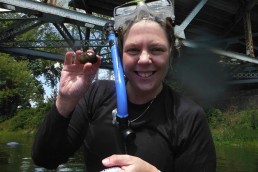Largest Mussel Relocation in History Set to Begin
SHARE THIS POST
The initial vehicle bridge spanning the Mississippi River between Moline and Bettendorf, Iowa was built in 1935. Vehicular traffic grew and an identical one was then built alongside the same one in 1959. When the federal interstate highway system was rolling along, those two bridges became part of Interstate 74. All Quad Cities folks know that planning, design and funding for a newer, bigger, better and safer bridge across the “father of waters” has been in the works for quite some time, and may soon become a reality.
The new structure is to be upstream from the old one and will have three lanes each direction and other amenities. Construction is slated to start next year and reports are it will take three years to complete with an estimated price tag over $1 billion.
I suspect that freshwater mussels living on the riverbed during the earlier bridge constructions were of little, if no concern 50 years ago. That has changed, and Kevin Cummings, a University of Illinois mussel expert, relayed information to me.
“Mussels are the ‘coal-mine canary’ of the Mississippi River,” Cummings said.
While the little shell creatures monitor water quality, they also filter it and clean it up.
“The Rock Island Field Office of the U.S. Fish and Wildlife Service has been involved in coordination of mussel relocation as part of the I-74 Bridge project for at least 15 years,” said Kristen Lundh, a U.S. Fish and Wildlife biologist, who also been an endangered species coordinator and has personally been involved for 13 years.
In 2014, a mussel study was performed to get a handle on how many and which species of mussels are living in the construction zone of the bridge, and, where those mussels could best be relocated. Some of the area—especially the Sylvan Slough location on the Illinois side—has many different mussels there.
The study area was strategically divided into four areas: three on the Illinois side and one on the Iowa side. Divers collected mussels from the riverbed inside 1-square meter increments, and then they calculated the average number per square meter in each of the four areas. The average numbers ranged from a low of 2.6 mussels/SM on the Iowa side, to a whopping 24.9 mussels /SM on the Illinois side in Sylvan Slough. From these numbers, the estimates total the number of mussels living in the construction zone to be an overwhelming 1.1 million.
Are you enjoying this post?
You can be among the first to get the latest info on where to go, what to use and how to use it!
Officials have identified the species in these locations.
“About 25 species are living there,” Lundh said. “Some common and plentiful, and some not so much. Of particular concern are three species on the Endangered Species List: Higgins’ eye pearly mussel, spectaclecase and sheepnose. There are five good sites (sand, gravel, small stone bottoms preferred) within the same Pool 15 for relocation that could accommodate an estimated 940,000 additional mussels. We plan to use just three of those sites.”
So the stage is set and relocation efforts are scheduled to start soon. The massive relocation project will be paid for with up to $5 million in total funds allocated by both the Illinois and Iowa Department of Transportation, but will probably cost less than that according to some DNR experts.
“We’re planning to relocate about a half-million mussels,” Lundh said. “Divers will collect mussels from the riverbed, then raise to the surface and transfer them to a crew on shore. Those folks will identify the species, mark them with a permanent ID number and measure each one. The endangered species will also get a tag powered by a tiny battery that will be ‘trackable’ so we can find and follow them.”
She added that the mussels would then be carefully transferred to new riverbed homes.
Lundh said the U.S. Fish and Wildlife and both Illinois and Iowa DNRs have been working together toward this mitigation strategy. She believes that in the future, doing additional research to determine how successful this project is, will affect future projects.
The work reportedly will be done on a 24-7 basis as long as there is safe weather and the water conditions are ideal. Boaters are cautioned that some access may be restricted at times, which is a temporary inconvenience considering the project will likely be the largest, most involved relocation of its kind.
Did you enjoy this post?
You can be among the first to get the latest info on where to go, what to use and how to use it!
Bob Groene
MidWest Outdoors works with more than 200 outdoor experts each year, who contribute articles based on their areas of expertise. MidWest Outdoors magazine offers more fishing and hunting articles than any other publication!

